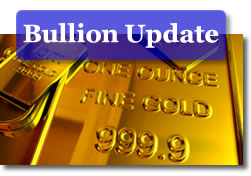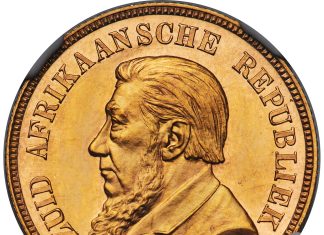 Gold prices declined nearly 1 percent and away from a six-week high on Thursday as the U.S. dollar rallied against the euro. Silver retreated by the same percentage while platinum edged higher.
Gold prices declined nearly 1 percent and away from a six-week high on Thursday as the U.S. dollar rallied against the euro. Silver retreated by the same percentage while platinum edged higher.
Crude oil fell as well after the dollar’s rise, but remained above $80 a barrel. U.S. stocks closed slightly higher, ending a volatile session.
New York precious metal figures follow:
-
Gold for April delivery declined $10.20, or 0.9 percent, to $1,133.10 an ounce. It ranged from $1,125.90 to $1,142.30.
-
Silver for May delivery retreated 15.3 cents, or 0.9 percent, to close at $17.176 an ounce. It ranged from $17.055 to $17.395.
- April platinum advanced a dime to close to $1,583.60 an ounce. It ranged from $1,566.70 to $1,589.40.
In PM London bullion, the benchmark gold price was fixed earlier in the North American day to $1,134.50 an ounce, which was a $2.00 decline from the price on Wednesday. Silver rose 17 cents to $17.340 an ounce. Platinum was settled at $1,579.00 an ounce, falling $1.00.
Notable bullion quotes follow:
"The dollar is only going to get stronger and stronger," Leonard Kaplan, the president of Prospector Asset Management in Evanston, Illinois, said on Bloomberg. "Everybody is beginning to realize that the ECB is cooked because the Greek problem is not going to go away. Investors will go back to the dollar, and gold goes lower."
"The metal still has to overcome resistance around $1,146 and $1,162 and is still vulnerable to E.U. – and euro- elated pressure, particularly as the threat of a ratings downgrade for Greece remains," analysts at TheBullionDesk.com were cited on MarketWatch.
"Gold prices came under initial selling pressure in New York this morning, falling for the first time in three days. This, as the US dollar continued to maintain and then climb," wrote Jon Nadler, senior analyst at Kitco Metals, Inc.
"Volatility in the greenback — not to mention in the euro — will continue for the remainder of the week and likely into the next one as well, as speculation mounts about the ECB’s inability to enact its exit strategy due to the Greek odyssey. Meanwhile, physical [gold] demand remained lackluster in India." [Read Nadler’s full commentary.]
Gold, considered a hedge during times of high inflation and economic uncertainty, tends to follow oil and move opposite to the U.S. dollar. A rising greenback makes dollar-denominated commodities, like bullion, more expensive for holders of other world currencies.
Oil and gasoline prices
Oil prices fell "as the dollar strengthened and some weak economic data soured sentiment after crude hit a seven-week high on Wednesday," wrote Edward McAllister of Reuters.
New York crude oil for April delivery declined 66 cents, or 0.8 percent, to $80.21 a barrel.
The national average for regular unleaded gasoline rose three-tenths of a cent to $2.706 a gallon, according to AAA fuel data. The current average is 1.3 cents above last week, 4.5 cents more than a month back, and 77.3 cents higher than the average from a year ago.
U.S. Stocks
U.S. stocks climbed modestly "as investors welcomed improved retail sales but showed caution after a worse-than-expected housing market report and ahead of Friday’s jobs report," wrote Alexandra Twin of CNNMoney.com.
"The U.S. productivity number is quite real," Hayes Miller, a Boston-based money manager at Baring Asset Management Inc., which manages $47.5 billion, said on Bloomberg. "I saw those figures this morning and my eyes popped. Productivity enhances your bottom- line, which is good for the stock market. And even though it’s tough to determine a trend for jobless claims, it’s obviously being perceived as a positive today."
The Dow Jones industrial average gained 47.38 points, or 0.46 percent, to 10,444.14. The S&P 500 Index advanced 4.18 points, or 0.37 percent, to 1,122.97. The Nasdaq Composite Index ended up 11.63 points, or 0.51 percent, to 2,292.31.
Gold, Silver, and Metals: Prices and Commentary – March 4, 2010
by Jon Nadler, Kitco Metals Inc.
Mr. Auric, Your Card Is Declined
Good Day,
The new round of Greek austerity measures was met with heavy resistance on the part of the domestic public over the past several hours. Angry demonstrators took over the Finance Ministry and General Accounting Office buildings in central Athens, while one of the major unions called for yet another strike.
These events are all underscoring the fact that the current Greek government is now facing the most challenging set of economic conditions in the country’s recent history. The strong budget medicine offered by Greek officials just yesterday, likely means that the average person’s disposable incomes will fall by at least 7% this year and that Greek consumer spending will contract by at least 3.5%.
On the other hand, the belt-tightening plan offered up by Athens has prompted European Commission officials to opine that given the plan’s degree of aggressiveness, there is no need –for now anyway– put any rescue plans of the country into motion. Thus, it is widely expected that when Prime Minister Papandreou pays a visit to Germany’s Angela Merkel tomorrow, there will be no momentous announcement coming in the wake of their parting handshakes.
In any case, the above, plus the manifest fragility in the Eurozone’s economic recovery prompted the ECB to keep rates steady at 1 percent this morning. Mr. Trichet, the head of the institution, observed that regional inflationary expectations remain "well-anchored" — a euphemism for: "we are skirting deflation here." The ECB also envisions next year’s zonal GDP as coming in at rather modest figures of between 0.5% and 2.5%.
Mr. Trichet warmly welcomed the Greek austerity measures, in a sigh of relief that no rescue cheques might have to be written by anyone, for the moment. Nevertheless, there is nothing out there that might prompt financial guru Dennis Gartman from –for the moment-taking back his opinion that:
"For all intents…the euro is doomed."
Over in the USA, initial jobless claims fell by 29,000 in the week ended February 7th, bringing the seasonally adjusted number to 469,000, the four-week average to 470,750 and halting a two-week-long period of sharp increases in initial filings (many attributed to the "snowmageddon" events that battered parts of the country during the period).
Meanwhile, the Labour Department reported that US productivity rose at a 6.9% annualized rate, in a revision from last month’s estimate of 6.2%. Unit labour costs fell by 1.7% (and by 5.9% overall) a number that may seem small at first blush, but, it represents the largest such decline since official record-keeping on such metrics began back in 1948.
Gold prices came under initial selling pressure in New York this morning, falling for the first time in three days and losing about $5 to ease to the $1135 level. This, as the US dollar continued to maintain and then climb well above the 80.00-mark on the index — a level which it recaptured late yesterday afternoon. Maintenance of support (previous resistance) near $1131-1135 might turn out to be today’s market battle.
Volatility in the greenback –not to mention in the euro– will continue for the remainder of the week and likely into the next one as well, as speculation mounts about the ECB’s inability to enact its exit strategy due to the Greek odyssey. Meanwhile, physical demand remained lackluster in India, where locals stayed away from the bazaars for a third day in a row based on expectations of lower price tags in the near-term.
The European common currency fell from a two-week high on a combination of those expectations and the steady stance on rates exhibited by the central bank this morning. Spot gold prices moved in a fairly narrow overnight and early morning range, mainly orbiting the $1137 pivot-point figure, as the trade digested the ECB decision and US jobless filings figures.
Analysts at Fortis Nederland NV envision gold prices continuing to notch new records in euro terms, based on what is called ‘cup & handle’ technical trading patterns on the charts. The price target of 900 euros has been mentioned by the Fortis analysts for the medium and longer term timeframe.
Silver managed a nickel’s worth of a climb, reaching $17.24 per ounce by 9:30 New York time. Platinum gave back $6 of yesterday’s gains, easing to $1571.00 per ounce, while palladium actually gained $8 to rise to the $455.00 per troy ounce figure. Rhodium bid prices once again showed no change at $2430.00.
Positive news on the gold supply front, from Down Under was reported this morning. The Australian Bureau of Agriculture and Resource Economics (ABARE) expects local gold production to rise by 10% in the coming fiscal year, likely reaching 267 tonnes by the first half of 2011. Good On Ya, Mates! We knew you could do it. This should keep the Perth Mint busy, to say the least.
Combine the rising Aussie output with China’s recent three-year-in-the-making string staggering achievements in gold mine production, and the wild and scary stories of ‘peak gold here and now’ can be safely placed on the back (very back) burner. But, you just know they won’t be.
Oh, and fears that a putative nationalization of S. Africa’s mines might destroy what’s left of that country’s output have also been placed on a shelf following a statement by the country’s trade minister yesterday, who said that such a development is not in S. Africa’s policy books at this time. Keep digging, at least for now, they will. At these profit margins, who wouldn’t?
In the interim, all kinds of offerings are springing up all over the place relating to gold in some fashion. ETFs, pseudo-ETFs, gold-backed credit cards (?!!!), and the like are vying for investors’ attention as the market starts into the new year. Some would-be US metals buyers got all excited when hearing of a new ETF that has presumably gotten around the pesky 28% capital gains treatment that even the mother-of-all gold ETFs was not able to avoid.
Index Universe‘s Mike Nadig, who did dig –into one such promising-sounding prospectus– came away with a different conclusion. Perhaps Uncle Sam will get his pound of gold(en) flesh, after all. One way, or another. You are free to make up your own mind. As for the newfangled gold-based credit cards, let’s see:
1) Send your Krugerrands/Eagles/etc. to a vault. 2) Obtain a credit card at 75% of the coins’ value as your credit limit (imagine checking your spending power every morning). 3) Go out and buy superfluous merchandise with the (ever-changing) value of your gold translated into purchasing fuel. Kind of defeats the purpose of owning that gold in the first place, no? It’s supposed to be a savings vehicle, not a spending one. Last time we checked, anyway. The mind boggles and wonders what that fine print contains. Let’s just call it a sign of the times. Anyone know how those gold-spewing ATMs are doing in Europe? Have not heard any statistics of late.
Happy Spending.
Jon Nadler
Senior Analyst
Kitco Metals Inc.
North America
Blog: http://www.kitco.com/ind/index.html#nadler










